深度学习网络模型——Swin-Transformer详细讲解与代码实现
论文名称:Swin Transformer: Hierarchical Vision Transformer using Shifted Windows
原论文地址: https://arxiv.org/abs/2103.14030
官方开源代码地址:https://github.com/microsoft/Swin-Transformer

一、网路模型整体架构
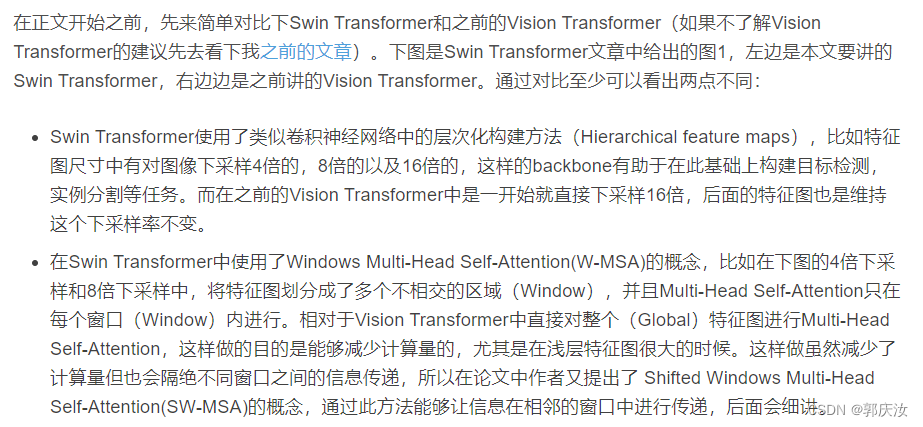
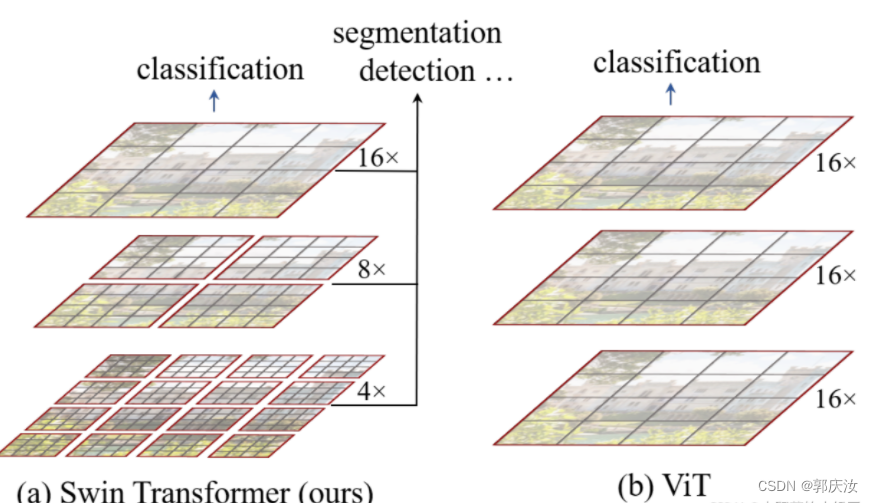

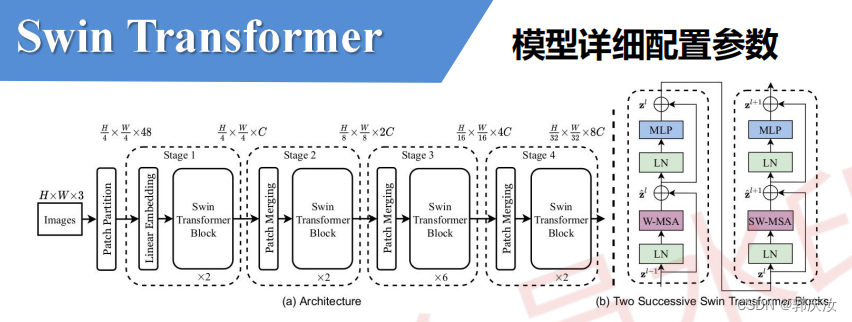

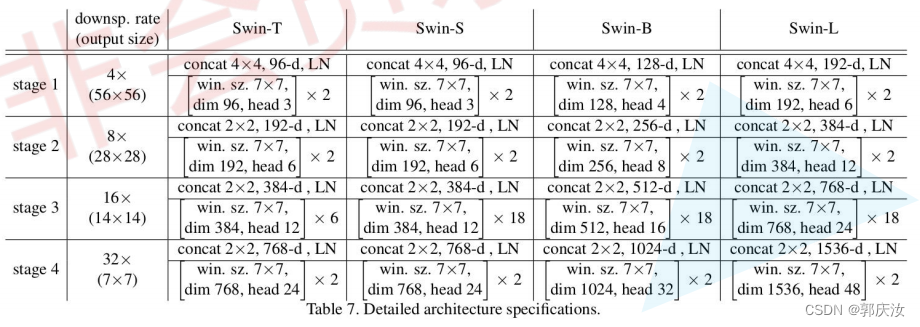
二、Patch Partition模块详解

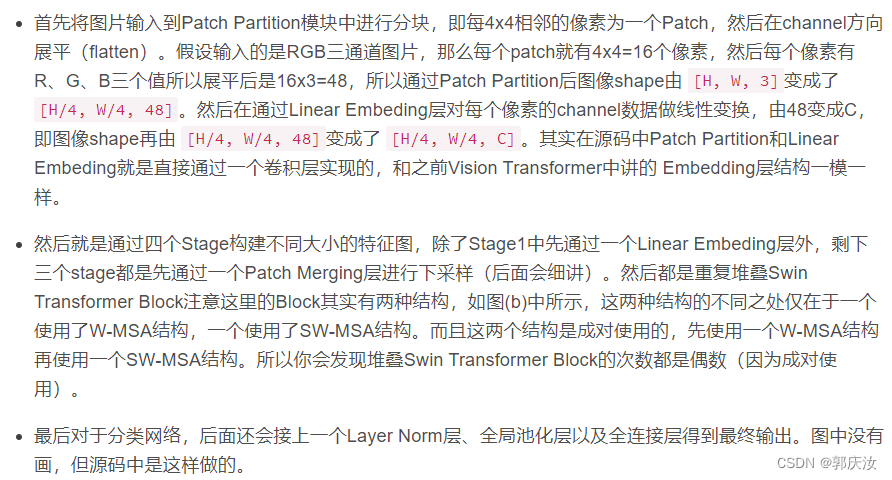

三、Patch Merging模块

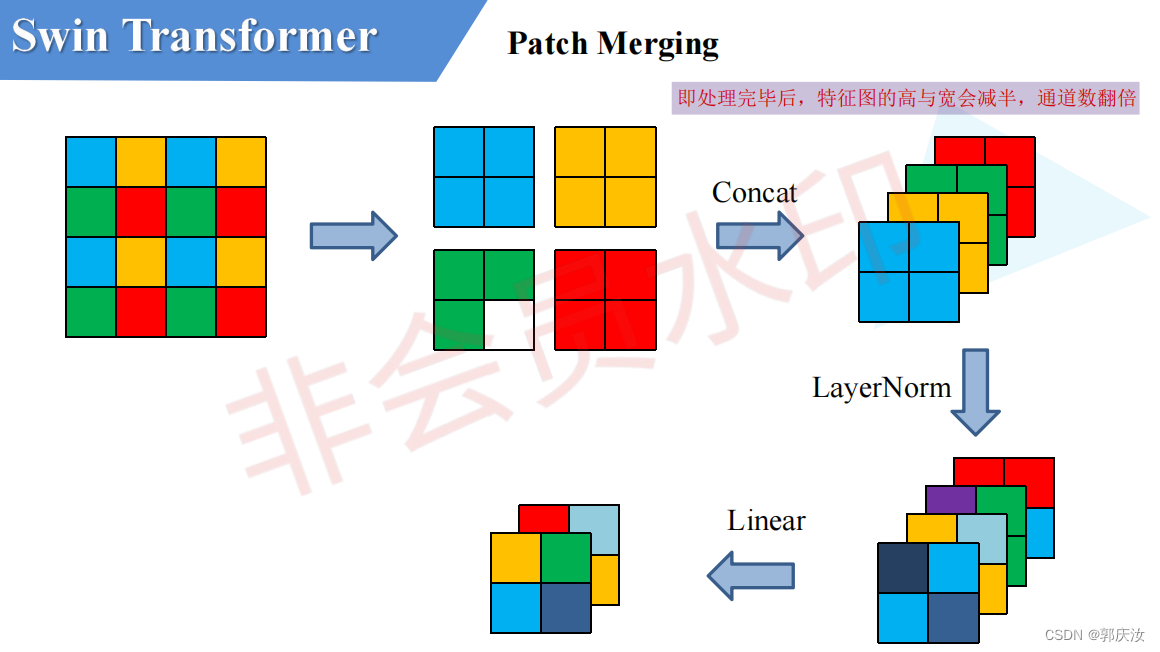
四、W-MSA详解

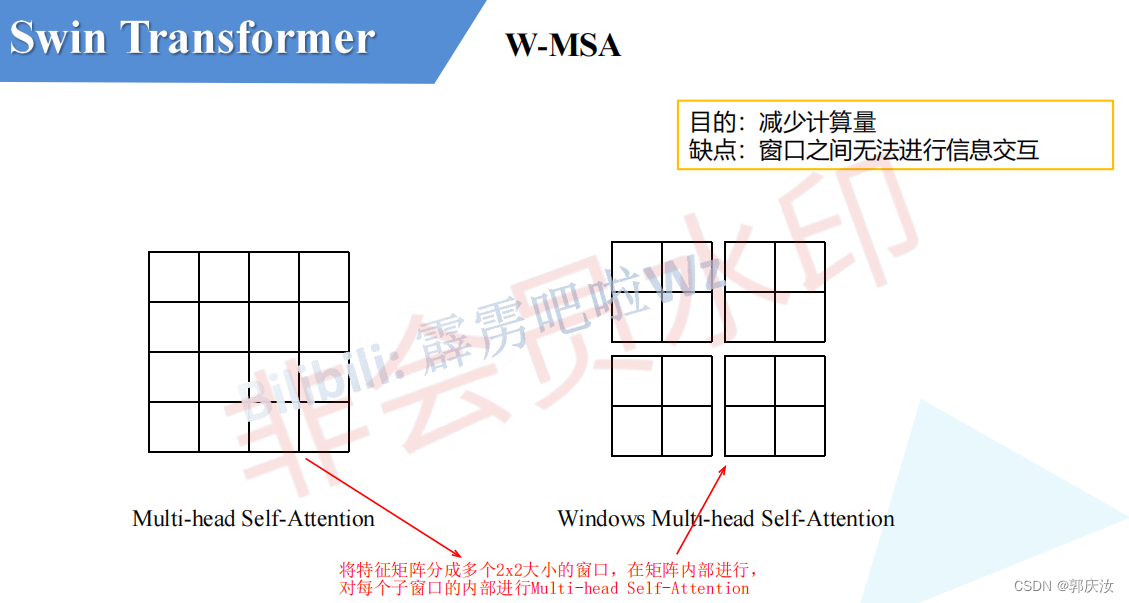
五、SW-MSA详解

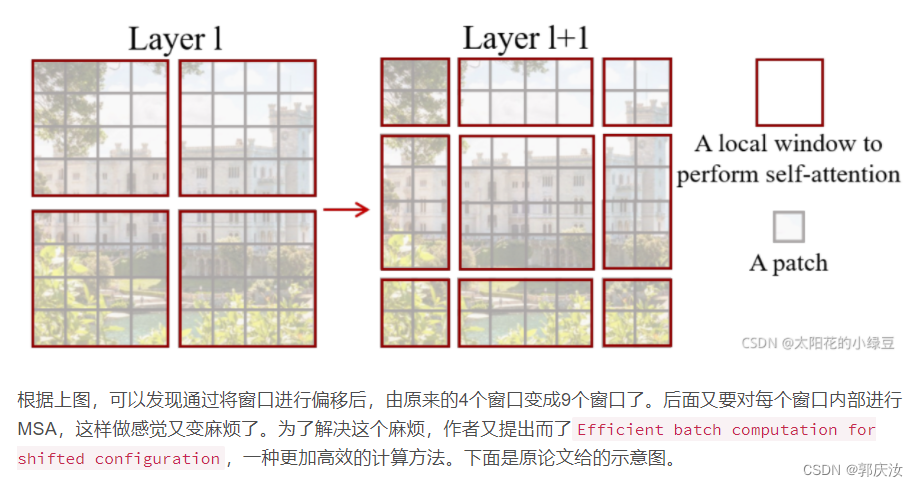


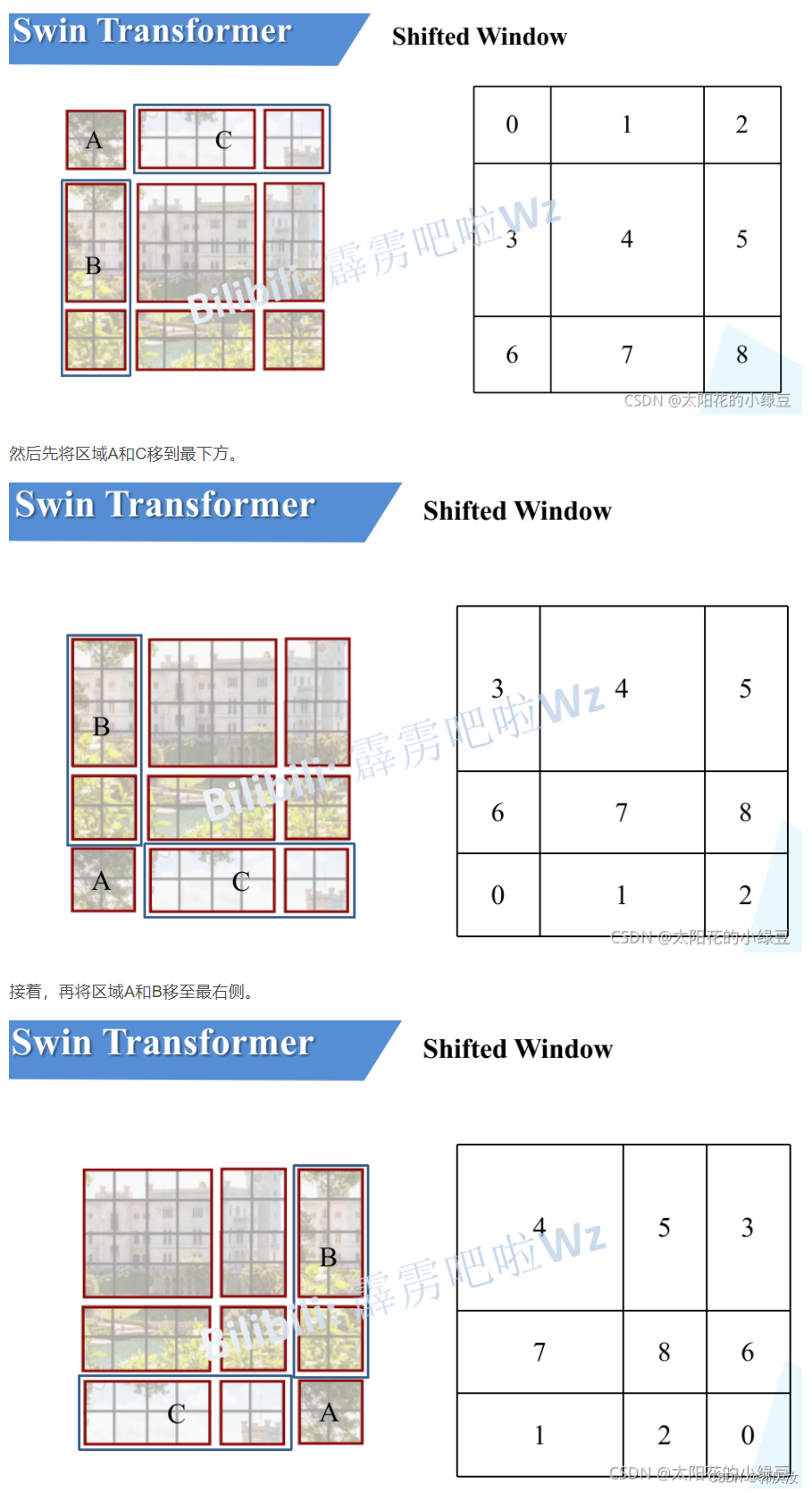


masked MSA详解

六、 Relative Position Bias详解
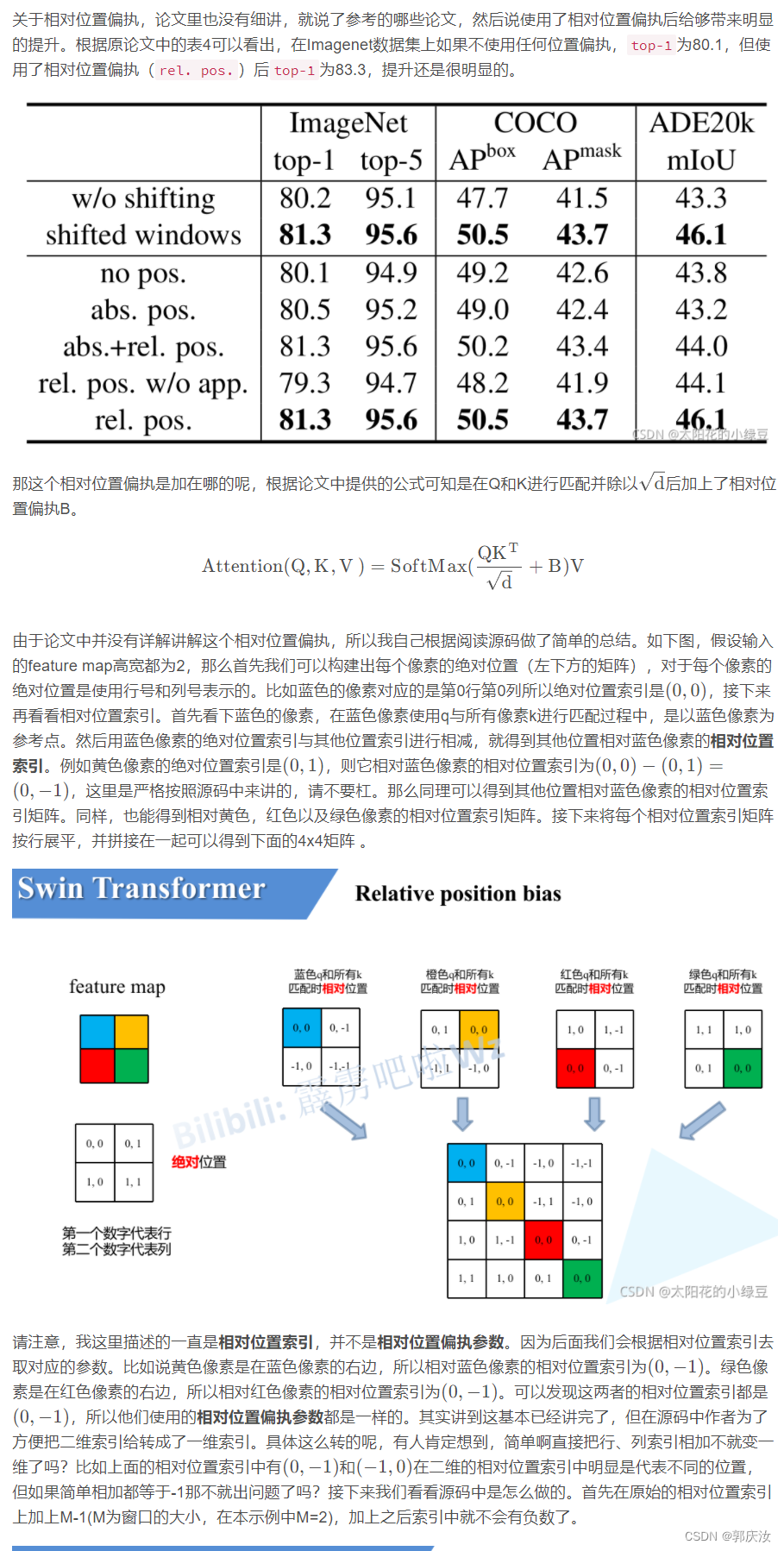
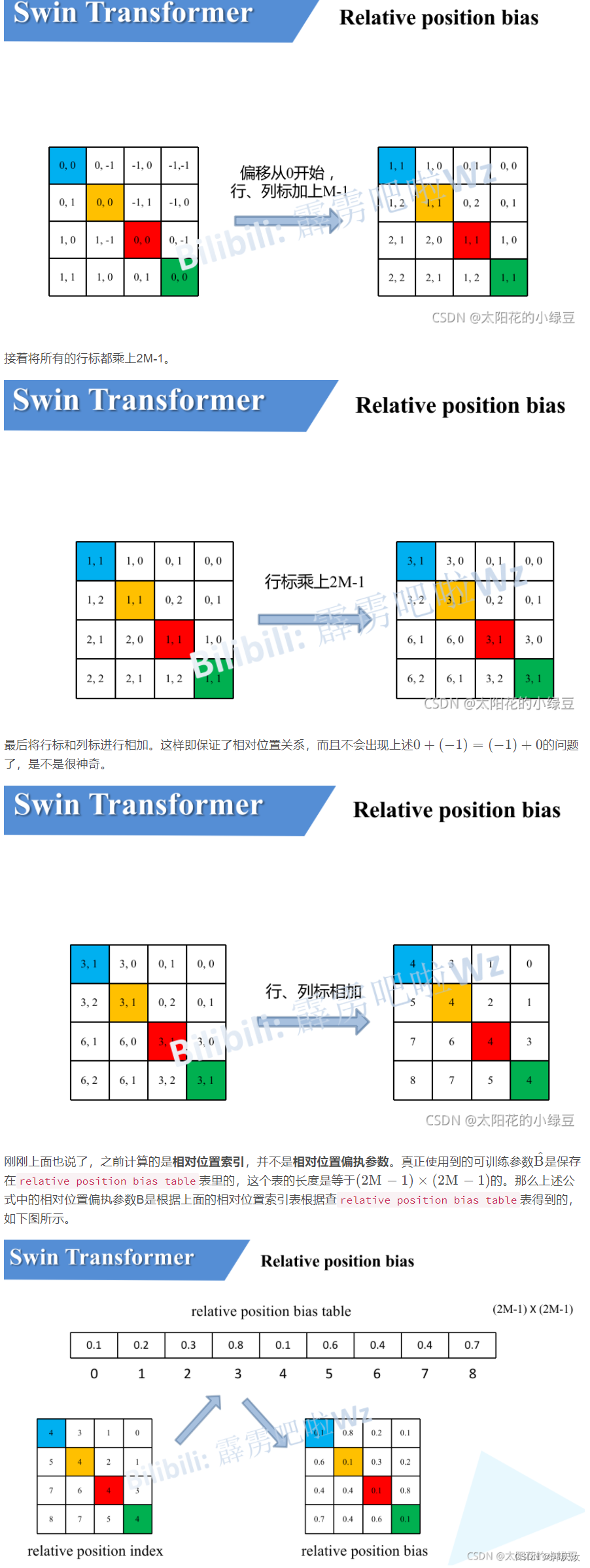
七、模型详细配置参数
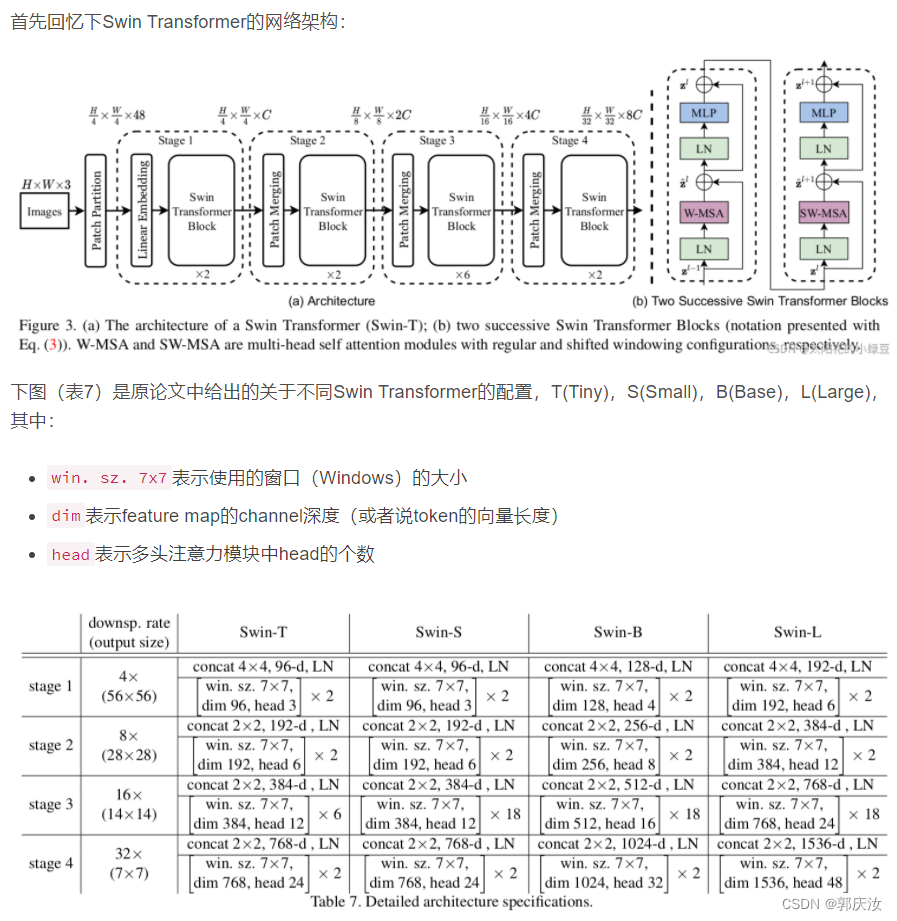
八、重要模块代码实现:
1、Patch Partition代码模块:
class PatchEmbed(nn.Module):"""
2D Image to Patch Embedding
split image into non-overlapping patches 即将图片划分成一个个没有重叠的patch
"""
def __init__(self, patch_size=4, in_c=3, embed_dim=96, norm_layer=None):super().__init__()
patch_size =(patch_size, patch_size)
self.patch_size = patch_size
self.in_chans = in_c
self.embed_dim = embed_dim
self.proj = nn.Conv2d(in_c, embed_dim, kernel_size=patch_size, stride=patch_size)
self.norm =norm_layer(embed_dim)if norm_layer else nn.Identity()
def forward(self, x):
_, _, H, W = x.shape
#padding
# 如果输入图片的H,W不是patch_size的整数倍,需要进行padding
pad_input =(H % self.patch_size[0]!=0)or(W % self.patch_size[1]!=0)if pad_input:#topad the last 3 dimensions,
# (W_left, W_right, H_top,H_bottom, C_front, C_back)
x = F.pad(x,(0, self.patch_size[1]- W % self.patch_size[1], # 表示宽度方向右侧填充数
0, self.patch_size[0]- H % self.patch_size[0], # 表示高度方向底部填充数
0,0))
# 下采样patch_size倍
x = self.proj(x)
_, _, H, W = x.shape
#flatten:[B, C, H, W]->[B, C, HW]#transpose:[B, C, HW]->[B, HW, C]
x = x.flatten(2).transpose(1,2)
x = self.norm(x)return x, H, W
2、Patch Merging代码模块:
class PatchMerging(nn.Module):
r""" Patch Merging Layer.
步长为2,间隔采样
Args:dim(int): Number of input channels.norm_layer(nn.Module, optional): Normalization layer. Default: nn.LayerNorm
"""
def __init__(self, dim, norm_layer=nn.LayerNorm):super().__init__()
self.dim = dim
self.reduction = nn.Linear(4* dim,2* dim, bias=False)
self.norm =norm_layer(4* dim)
def forward(self, x, H, W):"""
x: B, H*W, C 即输入x的通道排列顺序
"""
B, L, C = x.shape
assert L == H * W,"input feature has wrong size"
x = x.view(B, H, W, C)#padding
# 如果输入feature map的H,W不是2的整数倍,需要进行padding
pad_input =(H %2==1)or(W %2==1)if pad_input:#topad the last 3 dimensions, starting from the last dimension and moving forward.
# (C_front, C_back, W_left, W_right, H_top, H_bottom)
# 注意这里的Tensor通道是[B, H, W, C],所以会和官方文档有些不同
x = F.pad(x,(0,0,0, W %2,0, H %2))
# 以2为间隔进行采样
x0 = x[:,0::2,0::2,:] # [B, H/2, W/2, C]
x1 = x[:,1::2,0::2,:] # [B, H/2, W/2, C]
x2 = x[:,0::2,1::2,:] # [B, H/2, W/2, C]
x3 = x[:,1::2,1::2,:] # [B, H/2, W/2, C]
x = torch.cat([x0, x1, x2, x3],-1) # ————————>[B, H/2, W/2,4*C] 在channael维度上进行拼接
x = x.view(B,-1,4* C) # [B, H/2*W/2,4*C]
x = self.norm(x)
x = self.reduction(x) # [B, H/2*W/2,2*C]return x
3、mask掩码生成代码模块:
def create_mask(self, x, H, W):#calculateattention mask for SW-MSA
# 保证Hp和Wp是window_size的整数倍
Hp =int(np.ceil(H / self.window_size))* self.window_size
Wp =int(np.ceil(W / self.window_size))* self.window_size
# 拥有和feature map一样的通道排列顺序,方便后续window_partition
img_mask = torch.zeros((1, Hp, Wp,1), device=x.device) # [1, Hp, Wp,1]
h_slices =(slice(0,-self.window_size),slice(-self.window_size,-self.shift_size),slice(-self.shift_size, None))
w_slices =(slice(0,-self.window_size),slice(-self.window_size,-self.shift_size),slice(-self.shift_size, None))
cnt =0for h in h_slices:for w in w_slices:
img_mask[:, h, w,:]= cnt
cnt +=1
# 将img_mask划分成一个一个窗口
mask_windows =window_partition(img_mask, self.window_size) # [nW, Mh, Mw,1] # 输出的是按照指定的window_size划分成一个一个窗口的数据
mask_windows = mask_windows.view(-1, self.window_size * self.window_size) # [nW, Mh*Mw]
attn_mask = mask_windows.unsqueeze(1)- mask_windows.unsqueeze(2) # [nW,1, Mh*Mw]-[nW, Mh*Mw,1] 使用了广播机制
# [nW, Mh*Mw, Mh*Mw]
# 因为需要求得的是自身注意力机制,所以,所以相同的区域使用0表示,;不同的区域不等于0,填入-100,这样,在求得
attn_mask = attn_mask.masked_fill(attn_mask !=0,float(-100.0)).masked_fill(attn_mask ==0,float(0.0)) # 即对于不等于0的位置,赋值为-100;否则为0return attn_mask
4、stage堆叠部分代码:
class BasicLayer(nn.Module):"""
A basic Swin Transformer layer for one stage.
Args:dim(int): Number of input channels.depth(int): Number of blocks.num_heads(int): Number of attention heads.window_size(int): Local window size.mlp_ratio(float): Ratio of mlp hidden dim to embedding dim.qkv_bias(bool, optional): If True, add a learnable bias to query, key, value. Default: True
drop(float, optional): Dropout rate. Default:0.0attn_drop(float, optional): Attention dropout rate. Default:0.0drop_path(float| tuple[float], optional): Stochastic depth rate. Default:0.0norm_layer(nn.Module, optional): Normalization layer. Default: nn.LayerNorm
downsample(nn.Module | None, optional): Downsample layer at the end of the layer. Default: None
use_checkpoint(bool): Whether to use checkpointing to save memory. Default: False."""
def __init__(self, dim, depth, num_heads, window_size,
mlp_ratio=4., qkv_bias=True, drop=0., attn_drop=0.,
drop_path=0., norm_layer=nn.LayerNorm, downsample=None, use_checkpoint=False):super().__init__()
self.dim = dim
self.depth = depth
self.window_size = window_size
self.use_checkpoint = use_checkpoint
self.shift_size = window_size // 2 # 表示向右和向下偏移的窗口大小 即窗口大小除以2,然后向下取整#buildblocks
self.blocks = nn.ModuleList([SwinTransformerBlock(
dim=dim,
num_heads=num_heads,
window_size=window_size,
shift_size=0if(i %2==0)else self.shift_size, # 通过判断shift_size是否等于0,来决定是使用W-MSA与SW-MSA
mlp_ratio=mlp_ratio,
qkv_bias=qkv_bias,
drop=drop,
attn_drop=attn_drop,
drop_path=drop_path[i]ifisinstance(drop_path, list)else drop_path,
norm_layer=norm_layer)for i in range(depth)])#patchmerging layer 即:PatchMerging类if downsample is not None:
self.downsample =downsample(dim=dim, norm_layer=norm_layer)else:
self.downsample = None
def create_mask(self, x, H, W):#calculateattention mask for SW-MSA
# 保证Hp和Wp是window_size的整数倍
Hp =int(np.ceil(H / self.window_size))* self.window_size
Wp =int(np.ceil(W / self.window_size))* self.window_size
# 拥有和feature map一样的通道排列顺序,方便后续window_partition
img_mask = torch.zeros((1, Hp, Wp,1), device=x.device) # [1, Hp, Wp,1]
h_slices =(slice(0,-self.window_size),slice(-self.window_size,-self.shift_size),slice(-self.shift_size, None))
w_slices =(slice(0,-self.window_size),slice(-self.window_size,-self.shift_size),slice(-self.shift_size, None))
cnt =0for h in h_slices:for w in w_slices:
img_mask[:, h, w,:]= cnt
cnt +=1
# 将img_mask划分成一个一个窗口
mask_windows =window_partition(img_mask, self.window_size) # [nW, Mh, Mw,1] # 输出的是按照指定的window_size划分成一个一个窗口的数据
mask_windows = mask_windows.view(-1, self.window_size * self.window_size) # [nW, Mh*Mw]
attn_mask = mask_windows.unsqueeze(1)- mask_windows.unsqueeze(2) # [nW,1, Mh*Mw]-[nW, Mh*Mw,1] 使用了广播机制
# [nW, Mh*Mw, Mh*Mw]
# 因为需要求得的是自身注意力机制,所以,所以相同的区域使用0表示,;不同的区域不等于0,填入-100,这样,在求得
attn_mask = attn_mask.masked_fill(attn_mask !=0,float(-100.0)).masked_fill(attn_mask ==0,float(0.0)) # 即对于不等于0的位置,赋值为-100;否则为0return attn_mask
def forward(self, x, H, W):
attn_mask = self.create_mask(x, H, W) # [nW, Mh*Mw, Mh*Mw] # 制作mask蒙版
for blk in self.blocks:
blk.H, blk.W = H, W
if not torch.jit.is_scripting() and self.use_checkpoint:
x = checkpoint.checkpoint(blk, x, attn_mask)else:
x =blk(x, attn_mask)if self.downsample is not None:
x = self.downsample(x, H, W)
H, W =(H +1)// 2, (W + 1) // 2return x, H, W
5、SW-MSA或者W-MSA模块代码:
class SwinTransformerBlock(nn.Module):
r""" Swin Transformer Block.
Args:dim(int): Number of input channels.num_heads(int): Number of attention heads.window_size(int): Window size.shift_size(int): Shift size for SW-MSA.mlp_ratio(float): Ratio of mlp hidden dim to embedding dim.qkv_bias(bool, optional): If True, add a learnable bias to query, key, value. Default: True
drop(float, optional): Dropout rate. Default:0.0attn_drop(float, optional): Attention dropout rate. Default:0.0drop_path(float, optional): Stochastic depth rate. Default:0.0act_layer(nn.Module, optional): Activation layer. Default: nn.GELU
norm_layer(nn.Module, optional): Normalization layer. Default: nn.LayerNorm
"""
def __init__(self, dim, num_heads, window_size=7, shift_size=0,
mlp_ratio=4., qkv_bias=True, drop=0., attn_drop=0., drop_path=0.,
act_layer=nn.GELU, norm_layer=nn.LayerNorm):super().__init__()
self.dim = dim
self.num_heads = num_heads
self.window_size = window_size
self.shift_size = shift_size
self.mlp_ratio = mlp_ratio
assert 0<= self.shift_size < self.window_size,"shift_size must in 0-window_size"
self.norm1 =norm_layer(dim) # 先经过层归一化处理
#WindowAttention即为:SW-MSA或者W-MSA模块
self.attn =WindowAttention(
dim, window_size=(self.window_size, self.window_size), num_heads=num_heads, qkv_bias=qkv_bias,
attn_drop=attn_drop, proj_drop=drop)
self.drop_path =DropPath(drop_path)if drop_path >0.else nn.Identity()
self.norm2 =norm_layer(dim)
mlp_hidden_dim =int(dim * mlp_ratio)
self.mlp =Mlp(in_features=dim, hidden_features=mlp_hidden_dim, act_layer=act_layer, drop=drop)
def forward(self, x, attn_mask):
H, W = self.H, self.W
B, L, C = x.shape
assert L == H * W,"input feature has wrong size"
shortcut = x
x = self.norm1(x)
x = x.view(B, H, W, C)#padfeature maps to multiples of window size
# 把feature map给pad到window size的整数倍
pad_l =pad_t=0
pad_r =(self.window_size - W % self.window_size)% self.window_size
pad_b =(self.window_size - H % self.window_size)% self.window_size
x = F.pad(x,(0,0, pad_l, pad_r,pad_t, pad_b))
_, Hp, Wp, _ = x.shape
#cyclicshift
# 判断是进行SW-MSA或者是W-MSA模块
if self.shift_size >0:#https://blog.csdn.net/ooooocj/article/details/126046858?ops_request_misc=&request_id=&biz_id=102&utm_term=torch.roll()%E7%94%A8%E6%B3%95&utm_medium=distribute.pc_search_result.none-task-blog-2~all~sobaiduweb~default-0-126046858.142^v73^control,201^v4^add_ask,239^v1^control&spm=1018.2226.3001.4187
shifted_x = torch.roll(x, shifts=(-self.shift_size,-self.shift_size), dims=(1,2)) #进行数据移动操作
else:
shifted_x = x
attn_mask = None
#partitionwindows
# 将窗口按照window_size的大小进行划分,得到一个个窗口
x_windows =window_partition(shifted_x, self.window_size) # [nW*B, Mh, Mw, C]
# 将数据进行展平操作
x_windows = x_windows.view(-1, self.window_size * self.window_size, C) # [nW*B, Mh*Mw, C]#W-MSA/SW-MSA"""
# 进行多头自注意力机制操作
"""
attn_windows = self.attn(x_windows, mask=attn_mask) # [nW*B, Mh*Mw, C]#mergewindows
attn_windows = attn_windows.view(-1, self.window_size, self.window_size, C) # [nW*B, Mh, Mw, C]
# 将多窗口拼接回大的featureMap
shifted_x =window_reverse(attn_windows, self.window_size, Hp, Wp) # [B, H', W', C]#reversecyclic shift
# 将移位的数据进行还原
if self.shift_size >0:
x = torch.roll(shifted_x, shifts=(self.shift_size, self.shift_size), dims=(1,2))else:
x = shifted_x
# 如果进行了padding操作,需要移出掉相应的pad
if pad_r >0 or pad_b >0:
# 把前面pad的数据移除掉
x = x[:,:H,:W,:].contiguous()
x = x.view(B, H * W, C)#FFN
x = shortcut + self.drop_path(x)
x = x + self.drop_path(self.mlp(self.norm2(x)))return x
九:模型整体流程代码实现:
""" Swin Transformer
A PyTorch impl of : `Swin Transformer: Hierarchical Vision Transformer using Shifted Windows`
- https://arxiv.org/pdf/2103.14030
Code/weights from https://github.com/microsoft/Swin-Transformer"""
import torch
import torch.nn as nn
import torch.nn.functional as F
import torch.utils.checkpoint as checkpoint
import numpy as np
from typing import Optional
def drop_path_f(x, drop_prob:float=0., training: bool = False):"""Drop paths(Stochastic Depth) per sample(when applied in main path of residual blocks).
This is the same as the DropConnect impl I created for EfficientNet, etc networks, however,
the original name is misleading as 'Drop Connect' is a different form of dropout in a separate paper...
See discussion: https://github.com/tensorflow/tpu/issues/494#issuecomment-532968956 ... I've opted for
changing the layer and argument names to 'drop path' rather than mix DropConnect as a layer name and use
'survival rate' as the argument."""
if drop_prob ==0. or not training:return x
keep_prob =1- drop_prob
shape =(x.shape[0],)+(1,)*(x.ndim -1) # work with diff dim tensors, not just 2D ConvNets
random_tensor = keep_prob + torch.rand(shape, dtype=x.dtype, device=x.device)
random_tensor.floor_() # binarize
output = x.div(keep_prob)* random_tensor
return output
class DropPath(nn.Module):"""Drop paths(Stochastic Depth) per sample(when applied in main path of residual blocks)."""
def __init__(self, drop_prob=None):super(DropPath, self).__init__()
self.drop_prob = drop_prob
def forward(self, x):returndrop_path_f(x, self.drop_prob, self.training)"""
将窗口按照window_size的大小进行划分,得到一个个窗口
"""
def window_partition(x, window_size:int):"""
将feature map按照window_size划分成一个个没有重叠的window
Args:
x:(B, H, W, C)window_size(int): window size(M)
Returns:
windows:(num_windows*B, window_size, window_size, C)"""
B, H, W, C = x.shape
x = x.view(B, H // window_size, window_size, W // window_size, window_size, C)#permute:[B, H//Mh, Mh, W//Mw, Mw, C] -> [B, H//Mh, W//Mh, Mw, Mw, C]#view:[B, H//Mh, W//Mw, Mh, Mw, C] -> [B*num_windows, Mh, Mw, C]
windows = x.permute(0,1,3,2,4,5).contiguous().view(-1, window_size, window_size, C) # 输出的是按照指定的window_size划分成一个一个窗口的数据
return windows
def window_reverse(windows, window_size:int, H:int, W:int):"""
将一个个window还原成一个feature map
Args:
windows:(num_windows*B, window_size, window_size, C)window_size(int): Window size(M)H(int): Height of image
W(int): Width of image
Returns:
x:(B, H, W, C)"""
B =int(windows.shape[0]/(H * W / window_size / window_size))#view:[B*num_windows, Mh, Mw, C]->[B, H//Mh, W//Mw, Mh, Mw, C]
x = windows.view(B, H // window_size, W // window_size, window_size, window_size, -1)#permute:[B, H//Mh, W//Mw, Mh, Mw, C] -> [B, H//Mh, Mh, W//Mw, Mw, C]#view:[B, H//Mh, Mh, W//Mw, Mw, C] -> [B, H, W, C]
x = x.permute(0,1,3,2,4,5).contiguous().view(B, H, W,-1)return x
class PatchEmbed(nn.Module):"""
2D Image to Patch Embedding
split image into non-overlapping patches 即将图片划分成一个个没有重叠的patch
"""
def __init__(self, patch_size=4, in_c=3, embed_dim=96, norm_layer=None):super().__init__()
patch_size =(patch_size, patch_size)
self.patch_size = patch_size
self.in_chans = in_c
self.embed_dim = embed_dim
self.proj = nn.Conv2d(in_c, embed_dim, kernel_size=patch_size, stride=patch_size)
self.norm =norm_layer(embed_dim)if norm_layer else nn.Identity()
def forward(self, x):
_, _, H, W = x.shape
#padding
# 如果输入图片的H,W不是patch_size的整数倍,需要进行padding
pad_input =(H % self.patch_size[0]!=0)or(W % self.patch_size[1]!=0)if pad_input:#topad the last 3 dimensions,
# (W_left, W_right, H_top,H_bottom, C_front, C_back)
x = F.pad(x,(0, self.patch_size[1]- W % self.patch_size[1], # 表示宽度方向右侧填充数
0, self.patch_size[0]- H % self.patch_size[0], # 表示高度方向底部填充数
0,0))
# 下采样patch_size倍
x = self.proj(x)
_, _, H, W = x.shape
#flatten:[B, C, H, W]->[B, C, HW]#transpose:[B, C, HW]->[B, HW, C]
x = x.flatten(2).transpose(1,2)
x = self.norm(x)return x, H, W
class PatchMerging(nn.Module):
r""" Patch Merging Layer.
步长为2,间隔采样
Args:dim(int): Number of input channels.norm_layer(nn.Module, optional): Normalization layer. Default: nn.LayerNorm
"""
def __init__(self, dim, norm_layer=nn.LayerNorm):super().__init__()
self.dim = dim
self.reduction = nn.Linear(4* dim,2* dim, bias=False)
self.norm =norm_layer(4* dim)
def forward(self, x, H, W):"""
x: B, H*W, C 即输入x的通道排列顺序
"""
B, L, C = x.shape
assert L == H * W,"input feature has wrong size"
x = x.view(B, H, W, C)#padding
# 如果输入feature map的H,W不是2的整数倍,需要进行padding
pad_input =(H %2==1)or(W %2==1)if pad_input:#topad the last 3 dimensions, starting from the last dimension and moving forward.
# (C_front, C_back, W_left, W_right, H_top, H_bottom)
# 注意这里的Tensor通道是[B, H, W, C],所以会和官方文档有些不同
x = F.pad(x,(0,0,0, W %2,0, H %2))
# 以2为间隔进行采样
x0 = x[:,0::2,0::2,:] # [B, H/2, W/2, C]
x1 = x[:,1::2,0::2,:] # [B, H/2, W/2, C]
x2 = x[:,0::2,1::2,:] # [B, H/2, W/2, C]
x3 = x[:,1::2,1::2,:] # [B, H/2, W/2, C]
x = torch.cat([x0, x1, x2, x3],-1) # ————————>[B, H/2, W/2,4*C] 在channael维度上进行拼接
x = x.view(B,-1,4* C) # [B, H/2*W/2,4*C]
x = self.norm(x)
x = self.reduction(x) # [B, H/2*W/2,2*C]return x
"""
MLP模块
"""
class Mlp(nn.Module):""" MLP as used in Vision Transformer, MLP-Mixer and related networks
"""
def __init__(self, in_features, hidden_features=None, out_features=None, act_layer=nn.GELU, drop=0.):super().__init__()
out_features = out_features or in_features
hidden_features = hidden_features or in_features
self.fc1 = nn.Linear(in_features, hidden_features)
self.act =act_layer()
self.drop1 = nn.Dropout(drop)
self.fc2 = nn.Linear(hidden_features, out_features)
self.drop2 = nn.Dropout(drop)
def forward(self, x):
x = self.fc1(x)
x = self.act(x)
x = self.drop1(x)
x = self.fc2(x)
x = self.drop2(x)return x
"""
WindowAttention即为:SW-MSA或者W-MSA模块
"""
class WindowAttention(nn.Module):
r""" Window based multi-head self attention(W-MSA) module with relative position bias.
It supports both of shifted and non-shifted window.
Args:dim(int): Number of input channels.window_size(tuple[int]): The height and width of the window.num_heads(int): Number of attention heads.qkv_bias(bool, optional): If True, add a learnable bias to query, key, value. Default: True
attn_drop(float, optional): Dropout ratio of attention weight. Default:0.0proj_drop(float, optional): Dropout ratio of output. Default:0.0"""
def __init__(self, dim, window_size, num_heads, qkv_bias=True, attn_drop=0., proj_drop=0.):super().__init__()
self.dim = dim
self.window_size = window_size # [Mh, Mw]
self.num_heads = num_heads
head_dim = dim // num_heads
self.scale = head_dim **-0.5#defineaparameter table of relative position bias
# 创建偏置bias项矩阵
self.relative_position_bias_table = nn.Parameter(
torch.zeros((2* window_size[0]-1)*(2* window_size[1]-1), num_heads)) # [2*Mh-1*2*Mw-1, nH] 其元素的个数===>>[(2*Mh-1)*(2*Mw-1)]#getpair-wise relative position index for each token inside the window
coords_h = torch.arange(self.window_size[0]) # 如果此处的self.window_size[0]为2的话,则生成的coords_h为[0,1]
coords_w = torch.arange(self.window_size[1]) # 同理得
coords = torch.stack(torch.meshgrid([coords_h, coords_w])) # [2, Mh, Mw]
coords_flatten = torch.flatten(coords,1) # [2, Mh*Mw]
# [2, Mh*Mw,1]-[2,1, Mh*Mw]
relative_coords = coords_flatten[:,:, None]- coords_flatten[:, None,:] # [2, Mh*Mw, Mh*Mw]
relative_coords = relative_coords.permute(1,2,0).contiguous() # [Mh*Mw, Mh*Mw,2]
relative_coords[:,:,0]+= self.window_size[0]-1 # shift to start from 0 行标+(M-1)
relative_coords[:,:,1]+= self.window_size[1]-1 # 列表标+(M-1)
relative_coords[:,:,0]*=2* self.window_size[1]-1
relative_position_index = relative_coords.sum(-1) # [Mh*Mw, Mh*Mw]
self.register_buffer("relative_position_index", relative_position_index) # 将relative_position_index放入到模型的缓存当中
self.qkv = nn.Linear(dim, dim *3, bias=qkv_bias)
self.attn_drop = nn.Dropout(attn_drop)
self.proj = nn.Linear(dim, dim)
self.proj_drop = nn.Dropout(proj_drop)
nn.init.trunc_normal_(self.relative_position_bias_table, std=.02)
self.softmax = nn.Softmax(dim=-1)
def forward(self, x, mask: Optional[torch.Tensor]= None):"""
Args:
x: input features with shape of(num_windows*B, Mh*Mw, C)
mask:(0/-inf) mask with shape of(num_windows, Wh*Ww, Wh*Ww) or None
"""
# [batch_size*num_windows, Mh*Mw, total_embed_dim]
B_, N, C = x.shape
#qkv():->[batch_size*num_windows, Mh*Mw,3* total_embed_dim]#reshape:->[batch_size*num_windows, Mh*Mw,3, num_heads, embed_dim_per_head]#permute:->[3, batch_size*num_windows, num_heads, Mh*Mw, embed_dim_per_head]
qkv = self.qkv(x).reshape(B_, N,3, self.num_heads, C // self.num_heads).permute(2, 0, 3, 1, 4)
# [batch_size*num_windows, num_heads, Mh*Mw, embed_dim_per_head]
q, k, v = qkv.unbind(0) # make torchscript happy(cannot use tensor as tuple)#transpose:->[batch_size*num_windows, num_heads, embed_dim_per_head, Mh*Mw]
# @: multiply ->[batch_size*num_windows, num_heads, Mh*Mw, Mh*Mw]
q = q * self.scale
attn =(q @ k.transpose(-2,-1))#relative_position_bias_table.view:[Mh*Mw*Mh*Mw,nH]->[Mh*Mw,Mh*Mw,nH]
relative_position_bias = self.relative_position_bias_table[self.relative_position_index.view(-1)].view(
self.window_size[0]* self.window_size[1], self.window_size[0]* self.window_size[1],-1)
relative_position_bias = relative_position_bias.permute(2,0,1).contiguous() # [nH, Mh*Mw, Mh*Mw]
attn = attn + relative_position_bias.unsqueeze(0)
# 进行mask,相同区域使用0表示;不同区域使用-100表示
if mask is not None:#mask:[nW, Mh*Mw, Mh*Mw]
nW = mask.shape[0] # num_windows
#attn.view:[batch_size, num_windows, num_heads, Mh*Mw, Mh*Mw]#mask.unsqueeze:[1, nW,1, Mh*Mw, Mh*Mw]
attn = attn.view(B_ // nW, nW, self.num_heads, N, N) + mask.unsqueeze(1).unsqueeze(0)
attn = attn.view(-1, self.num_heads, N, N)
attn = self.softmax(attn)else:
attn = self.softmax(attn)
attn = self.attn_drop(attn)
# @: multiply ->[batch_size*num_windows, num_heads, Mh*Mw, embed_dim_per_head]#transpose:->[batch_size*num_windows, Mh*Mw, num_heads, embed_dim_per_head]#reshape:->[batch_size*num_windows, Mh*Mw, total_embed_dim]
x =(attn @ v).transpose(1,2).reshape(B_, N, C)
x = self.proj(x)
x = self.proj_drop(x)return x
"""
SwinTransformerBlock
"""
class SwinTransformerBlock(nn.Module):
r""" Swin Transformer Block.
Args:dim(int): Number of input channels.num_heads(int): Number of attention heads.window_size(int): Window size.shift_size(int): Shift size for SW-MSA.mlp_ratio(float): Ratio of mlp hidden dim to embedding dim.qkv_bias(bool, optional): If True, add a learnable bias to query, key, value. Default: True
drop(float, optional): Dropout rate. Default:0.0attn_drop(float, optional): Attention dropout rate. Default:0.0drop_path(float, optional): Stochastic depth rate. Default:0.0act_layer(nn.Module, optional): Activation layer. Default: nn.GELU
norm_layer(nn.Module, optional): Normalization layer. Default: nn.LayerNorm
"""
def __init__(self, dim, num_heads, window_size=7, shift_size=0,
mlp_ratio=4., qkv_bias=True, drop=0., attn_drop=0., drop_path=0.,
act_layer=nn.GELU, norm_layer=nn.LayerNorm):super().__init__()
self.dim = dim
self.num_heads = num_heads
self.window_size = window_size
self.shift_size = shift_size
self.mlp_ratio = mlp_ratio
assert 0<= self.shift_size < self.window_size,"shift_size must in 0-window_size"
self.norm1 =norm_layer(dim) # 先经过层归一化处理
#WindowAttention即为:SW-MSA或者W-MSA模块
self.attn =WindowAttention(
dim, window_size=(self.window_size, self.window_size), num_heads=num_heads, qkv_bias=qkv_bias,
attn_drop=attn_drop, proj_drop=drop)
self.drop_path =DropPath(drop_path)if drop_path >0.else nn.Identity()
self.norm2 =norm_layer(dim)
mlp_hidden_dim =int(dim * mlp_ratio)
self.mlp =Mlp(in_features=dim, hidden_features=mlp_hidden_dim, act_layer=act_layer, drop=drop)
def forward(self, x, attn_mask):
H, W = self.H, self.W
B, L, C = x.shape
assert L == H * W,"input feature has wrong size"
shortcut = x
x = self.norm1(x)
x = x.view(B, H, W, C)#padfeature maps to multiples of window size
# 把feature map给pad到window size的整数倍
pad_l =pad_t=0
pad_r =(self.window_size - W % self.window_size)% self.window_size
pad_b =(self.window_size - H % self.window_size)% self.window_size
x = F.pad(x,(0,0, pad_l, pad_r,pad_t, pad_b))
_, Hp, Wp, _ = x.shape
#cyclicshift
# 判断是进行SW-MSA或者是W-MSA模块
if self.shift_size >0:#https://blog.csdn.net/ooooocj/article/details/126046858?ops_request_misc=&request_id=&biz_id=102&utm_term=torch.roll()%E7%94%A8%E6%B3%95&utm_medium=distribute.pc_search_result.none-task-blog-2~all~sobaiduweb~default-0-126046858.142^v73^control,201^v4^add_ask,239^v1^control&spm=1018.2226.3001.4187
shifted_x = torch.roll(x, shifts=(-self.shift_size,-self.shift_size), dims=(1,2)) #进行数据移动操作
else:
shifted_x = x
attn_mask = None
#partitionwindows
# 将窗口按照window_size的大小进行划分,得到一个个窗口
x_windows =window_partition(shifted_x, self.window_size) # [nW*B, Mh, Mw, C]
# 将数据进行展平操作
x_windows = x_windows.view(-1, self.window_size * self.window_size, C) # [nW*B, Mh*Mw, C]#W-MSA/SW-MSA"""
# 进行多头自注意力机制操作
"""
attn_windows = self.attn(x_windows, mask=attn_mask) # [nW*B, Mh*Mw, C]#mergewindows
attn_windows = attn_windows.view(-1, self.window_size, self.window_size, C) # [nW*B, Mh, Mw, C]
# 将多窗口拼接回大的featureMap
shifted_x =window_reverse(attn_windows, self.window_size, Hp, Wp) # [B, H', W', C]#reversecyclic shift
# 将移位的数据进行还原
if self.shift_size >0:
x = torch.roll(shifted_x, shifts=(self.shift_size, self.shift_size), dims=(1,2))else:
x = shifted_x
# 如果进行了padding操作,需要移出掉相应的pad
if pad_r >0 or pad_b >0:
# 把前面pad的数据移除掉
x = x[:,:H,:W,:].contiguous()
x = x.view(B, H * W, C)#FFN
x = shortcut + self.drop_path(x)
x = x + self.drop_path(self.mlp(self.norm2(x)))return x
class BasicLayer(nn.Module):"""
A basic Swin Transformer layer for one stage.
Args:dim(int): Number of input channels.depth(int): Number of blocks.num_heads(int): Number of attention heads.window_size(int): Local window size.mlp_ratio(float): Ratio of mlp hidden dim to embedding dim.qkv_bias(bool, optional): If True, add a learnable bias to query, key, value. Default: True
drop(float, optional): Dropout rate. Default:0.0attn_drop(float, optional): Attention dropout rate. Default:0.0drop_path(float| tuple[float], optional): Stochastic depth rate. Default:0.0norm_layer(nn.Module, optional): Normalization layer. Default: nn.LayerNorm
downsample(nn.Module | None, optional): Downsample layer at the end of the layer. Default: None
use_checkpoint(bool): Whether to use checkpointing to save memory. Default: False."""
def __init__(self, dim, depth, num_heads, window_size,
mlp_ratio=4., qkv_bias=True, drop=0., attn_drop=0.,
drop_path=0., norm_layer=nn.LayerNorm, downsample=None, use_checkpoint=False):super().__init__()
self.dim = dim
self.depth = depth
self.window_size = window_size
self.use_checkpoint = use_checkpoint
self.shift_size = window_size // 2 # 表示向右和向下偏移的窗口大小 即窗口大小除以2,然后向下取整#buildblocks
self.blocks = nn.ModuleList([SwinTransformerBlock(
dim=dim,
num_heads=num_heads,
window_size=window_size,
shift_size=0if(i %2==0)else self.shift_size, # 通过判断shift_size是否等于0,来决定是使用W-MSA与SW-MSA
mlp_ratio=mlp_ratio,
qkv_bias=qkv_bias,
drop=drop,
attn_drop=attn_drop,
drop_path=drop_path[i]ifisinstance(drop_path, list)else drop_path,
norm_layer=norm_layer)for i in range(depth)])#patchmerging layer 即:PatchMerging类if downsample is not None:
self.downsample =downsample(dim=dim, norm_layer=norm_layer)else:
self.downsample = None
def create_mask(self, x, H, W):#calculateattention mask for SW-MSA
# 保证Hp和Wp是window_size的整数倍
Hp =int(np.ceil(H / self.window_size))* self.window_size
Wp =int(np.ceil(W / self.window_size))* self.window_size
# 拥有和feature map一样的通道排列顺序,方便后续window_partition
img_mask = torch.zeros((1, Hp, Wp,1), device=x.device) # [1, Hp, Wp,1]
h_slices =(slice(0,-self.window_size),slice(-self.window_size,-self.shift_size),slice(-self.shift_size, None))
w_slices =(slice(0,-self.window_size),slice(-self.window_size,-self.shift_size),slice(-self.shift_size, None))
cnt =0for h in h_slices:for w in w_slices:
img_mask[:, h, w,:]= cnt
cnt +=1
# 将img_mask划分成一个一个窗口
mask_windows =window_partition(img_mask, self.window_size) # [nW, Mh, Mw,1] # 输出的是按照指定的window_size划分成一个一个窗口的数据
mask_windows = mask_windows.view(-1, self.window_size * self.window_size) # [nW, Mh*Mw]
attn_mask = mask_windows.unsqueeze(1)- mask_windows.unsqueeze(2) # [nW,1, Mh*Mw]-[nW, Mh*Mw,1] 使用了广播机制
# [nW, Mh*Mw, Mh*Mw]
# 因为需要求得的是自身注意力机制,所以,所以相同的区域使用0表示,;不同的区域不等于0,填入-100,这样,在求得
attn_mask = attn_mask.masked_fill(attn_mask !=0,float(-100.0)).masked_fill(attn_mask ==0,float(0.0)) # 即对于不等于0的位置,赋值为-100;否则为0return attn_mask
def forward(self, x, H, W):
attn_mask = self.create_mask(x, H, W) # [nW, Mh*Mw, Mh*Mw] # 制作mask蒙版
for blk in self.blocks:
blk.H, blk.W = H, W
if not torch.jit.is_scripting() and self.use_checkpoint:
x = checkpoint.checkpoint(blk, x, attn_mask)else:
x =blk(x, attn_mask)if self.downsample is not None:
x = self.downsample(x, H, W)
H, W =(H +1)// 2, (W + 1) // 2return x, H, W
class SwinTransformer(nn.Module):
r""" Swin Transformer
A PyTorch impl of : `Swin Transformer: Hierarchical Vision Transformer using Shifted Windows` -
https://arxiv.org/pdf/2103.14030
Args:patch_size(int|tuple(int)): Patch size. Default:4 表示通过Patch Partition层后,下采样几倍
in_chans(int): Number of input image channels. Default:3num_classes(int): Number of classes for classification head. Default:1000embed_dim(int): Patch embedding dimension. Default:96depths(tuple(int)): Depth of each Swin Transformer layer.num_heads(tuple(int)): Number of attention heads in different layers.window_size(int): Window size. Default:7mlp_ratio(float): Ratio of mlp hidden dim to embedding dim. Default:4qkv_bias(bool): If True, add a learnable bias to query, key, value. Default: True
drop_rate(float): Dropout rate. Default:0attn_drop_rate(float): Attention dropout rate. Default:0drop_path_rate(float): Stochastic depth rate. Default:0.1norm_layer(nn.Module): Normalization layer. Default: nn.LayerNorm.patch_norm(bool): If True, add normalization after patch embedding. Default: True
use_checkpoint(bool): Whether to use checkpointing to save memory. Default: False
"""
def __init__(self, patch_size=4, # 表示通过Patch Partition层后,下采样几倍
in_chans=3, # 输入图像通道
num_classes=1000, # 类别数
embed_dim=96, # Patch partition层后的LinearEmbedding层映射后的维度,之后的几层都是该数的整数倍 分别是 C、2C、4C、8C
depths=(2,2,6,2), # 表示每一个Stage模块内,Swin Transformer Block重复的次数
num_heads=(3,6,12,24), # 表示每一个Stage模块内,Swin Transformer Block中采用的Multi-Head self-Attention的head的个数
window_size=7, # 表示W-MSA与SW-MSA所采用的window的大小
mlp_ratio=4., # 表示MLP模块中,第一个全连接层增大的倍数
qkv_bias=True,
drop_rate=0., # 对应的PatchEmbed层后面的
attn_drop_rate=0., # 对应于Multi-Head self-Attention模块中对应的dropRate
drop_path_rate=0.1, # 对应于每一个Swin-Transformer模块中采用的DropRate 其是慢慢的递增的,从0增长到drop_path_rate
norm_layer=nn.LayerNorm,
patch_norm=True,
use_checkpoint=False,**kwargs):super().__init__()
self.num_classes = num_classes
self.num_layers =len(depths) # depths:表示重复的Swin Transoformer Block模块的次数 表示每一个Stage模块内,Swin Transformer Block重复的次数
self.embed_dim = embed_dim
self.patch_norm = patch_norm
#stage4输出特征矩阵的channels
self.num_features =int(embed_dim *2**(self.num_layers -1))
self.mlp_ratio = mlp_ratio
#splitimage into non-overlapping patches 即将图片划分成一个个没有重叠的patch
self.patch_embed =PatchEmbed(
patch_size=patch_size, in_c=in_chans, embed_dim=embed_dim,
norm_layer=norm_layer if self.patch_norm else None)
self.pos_drop = nn.Dropout(p=drop_rate) # PatchEmbed层后面的Dropout层
#stochasticdepth
dpr =[x.item()for x in torch.linspace(0, drop_path_rate,sum(depths))] # stochastic depth decay rule
#buildlayers
self.layers = nn.ModuleList()for i_layer in range(self.num_layers):
# 注意这里构建的stage和论文图中有些差异
# 这里的stage不包含该stage的patch_merging层,包含的是下个stage的
layers =BasicLayer(dim=int(embed_dim *2** i_layer), # 传入特征矩阵的维度,即channel方向的深度
depth=depths[i_layer], # 表示当前stage中需要堆叠的多少Swin Transformer Block
num_heads=num_heads[i_layer], # 表示每一个Stage模块内,Swin Transformer Block中采用的Multi-Head self-Attention的head的个数
window_size=window_size, # 表示W-MSA与SW-MSA所采用的window的大小
mlp_ratio=self.mlp_ratio, # 表示MLP模块中,第一个全连接层增大的倍数
qkv_bias=qkv_bias,
drop=drop_rate, # 对应的PatchEmbed层后面的
attn_drop=attn_drop_rate, # 对应于Multi-Head self-Attention模块中对应的dropRate
drop_path=dpr[sum(depths[:i_layer]):sum(depths[:i_layer +1])], # 对应于每一个Swin-Transformer模块中采用的DropRate 其是慢慢的递增的,从0增长到drop_path_rate
norm_layer=norm_layer,
downsample=PatchMerging if(i_layer < self.num_layers -1)else None, # 判断是否是第四个,因为第四个Stage是没有PatchMerging层的
use_checkpoint=use_checkpoint)
self.layers.append(layers)
self.norm =norm_layer(self.num_features)
self.avgpool = nn.AdaptiveAvgPool1d(1) # 自适应的全局平均池化
self.head = nn.Linear(self.num_features, num_classes)if num_classes >0else nn.Identity()
self.apply(self._init_weights)
def _init_weights(self, m):ifisinstance(m, nn.Linear):
nn.init.trunc_normal_(m.weight, std=.02)ifisinstance(m, nn.Linear) and m.bias is not None:
nn.init.constant_(m.bias,0)
elif isinstance(m, nn.LayerNorm):
nn.init.constant_(m.bias,0)
nn.init.constant_(m.weight,1.0)
def forward(self, x):#x:[B, L, C]
x, H, W = self.patch_embed(x) # 对图像下采样4倍
x = self.pos_drop(x)
# 依次传入各个stage中
for layer in self.layers:
x, H, W =layer(x, H, W)
x = self.norm(x) # [B, L, C]
x = self.avgpool(x.transpose(1,2)) # [B, C,1]
x = torch.flatten(x,1)
x = self.head(x) # 经过全连接层,得到输出
return x
def swin_tiny_patch4_window7_224(num_classes:int=1000,**kwargs):#trainedImageNet-1K#https://github.com/SwinTransformer/storage/releases/download/v1.0.0/swin_tiny_patch4_window7_224.pth
model =SwinTransformer(in_chans=3,
patch_size=4,
window_size=7,
embed_dim=96,
depths=(2,2,6,2),
num_heads=(3,6,12,24),
num_classes=num_classes,**kwargs)return model
def swin_small_patch4_window7_224(num_classes:int=1000,**kwargs):#trainedImageNet-1K#https://github.com/SwinTransformer/storage/releases/download/v1.0.0/swin_small_patch4_window7_224.pth
model =SwinTransformer(in_chans=3,
patch_size=4,
window_size=7,
embed_dim=96,
depths=(2,2,18,2),
num_heads=(3,6,12,24),
num_classes=num_classes,**kwargs)return model
def swin_base_patch4_window7_224(num_classes:int=1000,**kwargs):#trainedImageNet-1K#https://github.com/SwinTransformer/storage/releases/download/v1.0.0/swin_base_patch4_window7_224.pth
model =SwinTransformer(in_chans=3,
patch_size=4,
window_size=7,
embed_dim=128,
depths=(2,2,18,2),
num_heads=(4,8,16,32),
num_classes=num_classes,**kwargs)return model
def swin_base_patch4_window12_384(num_classes:int=1000,**kwargs):#trainedImageNet-1K#https://github.com/SwinTransformer/storage/releases/download/v1.0.0/swin_base_patch4_window12_384.pth
model =SwinTransformer(in_chans=3,
patch_size=4,
window_size=12,
embed_dim=128,
depths=(2,2,18,2),
num_heads=(4,8,16,32),
num_classes=num_classes,**kwargs)return model
def swin_base_patch4_window7_224_in22k(num_classes:int=21841,**kwargs):#trainedImageNet-22K#https://github.com/SwinTransformer/storage/releases/download/v1.0.0/swin_base_patch4_window7_224_22k.pth
model =SwinTransformer(in_chans=3,
patch_size=4,
window_size=7,
embed_dim=128,
depths=(2,2,18,2),
num_heads=(4,8,16,32),
num_classes=num_classes,**kwargs)return model
def swin_base_patch4_window12_384_in22k(num_classes:int=21841,**kwargs):#trainedImageNet-22K#https://github.com/SwinTransformer/storage/releases/download/v1.0.0/swin_base_patch4_window12_384_22k.pth
model =SwinTransformer(in_chans=3,
patch_size=4,
window_size=12,
embed_dim=128,
depths=(2,2,18,2),
num_heads=(4,8,16,32),
num_classes=num_classes,**kwargs)return model
def swin_large_patch4_window7_224_in22k(num_classes:int=21841,**kwargs):#trainedImageNet-22K#https://github.com/SwinTransformer/storage/releases/download/v1.0.0/swin_large_patch4_window7_224_22k.pth
model =SwinTransformer(in_chans=3,
patch_size=4,
window_size=7,
embed_dim=192,
depths=(2,2,18,2),
num_heads=(6,12,24,48),
num_classes=num_classes,**kwargs)return model
def swin_large_patch4_window12_384_in22k(num_classes:int=21841,**kwargs):#trainedImageNet-22K#https://github.com/SwinTransformer/storage/releases/download/v1.0.0/swin_large_patch4_window12_384_22k.pth
model =SwinTransformer(in_chans=3,
patch_size=4,
window_size=12,
embed_dim=192,
depths=(2,2,18,2),
num_heads=(6,12,24,48),
num_classes=num_classes,**kwargs)return model
版权归原作者 郭庆汝 所有, 如有侵权,请联系我们删除。